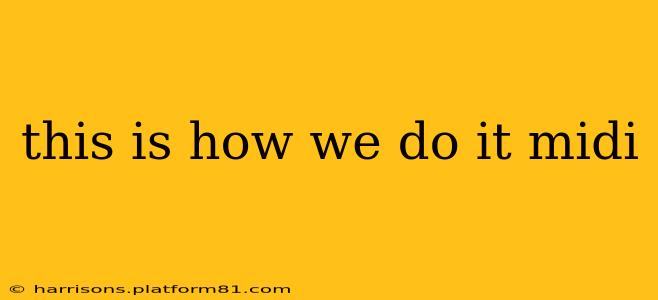This Is How We Do It: A Deep Dive into the MIDI Revolution
"This Is How We Do It" – the iconic 90s hit by Montell Jordan – wasn't just a catchy tune; it was a soundtrack to a technological revolution in music production: MIDI. While the song itself doesn't directly mention MIDI, its sophisticated sound, layered with synthesized instruments and precise rhythmic elements, perfectly encapsulates the possibilities unlocked by this powerful technology. This article will explore the world of MIDI, explaining what it is, how it works, and its lasting impact on music creation.
What is MIDI?
MIDI, or Musical Instrument Digital Interface, isn't a sound itself; it's a communication protocol. Think of it as a language that electronic musical instruments and computers use to talk to each other. Instead of transmitting raw audio data (like a WAV file), MIDI transmits instructions. These instructions tell a synthesizer what note to play, how loud to play it, how long to hold it, and even what effects to apply. This makes MIDI incredibly efficient, allowing for complex musical arrangements to be stored in relatively small files.
How Does MIDI Work?
MIDI data travels as a series of messages along a cable or wireless connection. These messages contain instructions like:
- Note On/Off: Triggers the playing and stopping of notes.
- Velocity: Controls the volume or intensity of a note.
- Pitch Bend: Allows for subtle changes in pitch, like bending a note slightly.
- Program Change: Selects different instrument sounds (patches) from a synthesizer.
- Controller Changes: Adjusts parameters like modulation, vibrato, or effects.
This data is interpreted by a MIDI device, such as a synthesizer, sound module, or computer equipped with a sound card or virtual instrument. The device then translates the MIDI instructions into actual audio sounds.
What are the Advantages of Using MIDI?
MIDI offers numerous advantages for musicians and producers:
- Flexibility: Easily edit and rearrange musical parts without re-recording.
- Efficiency: Small file sizes compared to audio recordings.
- Versatility: Control a wide range of instruments and effects.
- Non-destructive editing: Changes are made to the instructions, not the audio itself.
- Automation: Create complex musical movements and effects automatically.
What are Some Common MIDI Devices?
The MIDI landscape encompasses a broad range of hardware and software. Some examples include:
- MIDI Keyboards: These keyboards transmit MIDI data, allowing you to play virtual instruments or control hardware synths.
- MIDI Controllers: Devices like pads, knobs, and faders that provide hands-on control over various parameters.
- Digital Audio Workstations (DAWs): Software programs like Ableton Live, Logic Pro X, and Pro Tools that use MIDI to sequence and arrange music.
- Synthesizers and Sound Modules: Hardware instruments that respond to MIDI commands to generate sounds.
Can I Use MIDI With My Existing Instruments?
Many modern instruments feature MIDI capabilities, allowing you to integrate them into a computer-based music production setup. However, older instruments may require a MIDI interface or converter to work with MIDI technology.
What are Some Popular MIDI Applications?
MIDI's applications are vast and continue to evolve. Here are a few notable uses:
- Music Production: Creating and sequencing music in a DAW.
- Sound Design: Manipulating and controlling synthesizer parameters.
- Live Performance: Controlling instruments, lights, and other stage effects.
- Music Education: Learning music theory and practicing musical skills.
Conclusion: The Enduring Legacy of MIDI
From the sophisticated sounds of "This Is How We Do It" to countless other musical masterpieces, MIDI has fundamentally reshaped how music is created, performed, and experienced. Its efficiency, flexibility, and versatility ensure its continued relevance in the ever-evolving world of music technology. The language of MIDI continues to speak volumes, allowing musicians to express themselves with unprecedented control and creativity.
